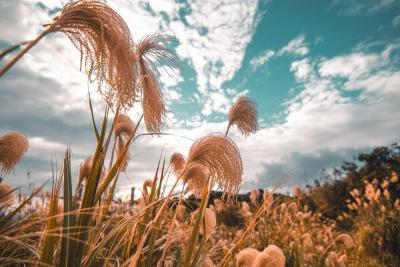Enhancing the Community Terrestrial System Model to Grow Perennial Bioenergy Crops
With projected expansion of biofuel production at a global scale, accurately representing biofuel crops in land surface models can help estimate potential impacts of land use changes. Using observations from biofuel plants in the Midwestern United States, a team of researchers at the Pacific Northwest National Laboratory (PNNL) and the University of Illinois at Urbana‐Champaign (UIUC) simulated two biofuel perennial plants, Miscanthus and switchgrass, in the Community Terrestrial System Model (CTSM; formerly known as the Community Land Model [CLM]). Their simulations indicate these high-yield perennial crops assimilate more CO2 and demand less nutrients and water than traditional annual crops. This suggests Miscanthus and switchgrass are promising alternatives for bioenergy feedstocks.
This study constitutes the first attempt to simulate perennial bioenergy crops in CTSM. With this enhancement, CTSM becomes one of the first land models that can evaluate the complex energy-water-land-climate dynamics of energy technology advances with potential biofuel expansion at local, regional, and global scales.
This study establishes the foundation for examining the impact of extensive plantations of bioenergy crops on terrestrial hydrological and biogeochemical cycles as well as surface energy partitioning. Researchers implemented Miscanthus and switchgrass into CTSM using parameters for photosynthesis, seasonal changes, resource allocation, plant decomposition, and carbon cost for nitrogen uptake, while simultaneously integrating land management practices. When the simulations were validated against site‐level measurements, they demonstrated the model was capable of capturing both overall patterns of carbon and energy fluxes and the plants’ growth from leaf emergence to old age.
Miscanthus and switchgrass tend to be more productive than maize-soybean rotation and offer larger net carbon sinks as a result of their longer growing season, larger leaf areas, and above‐ground biomass. Compared to annual crops, this leads to increased transpiration, lower annual runoff, and larger carbon uptake. The model simulations suggest that with higher CO2 assimilation rates and lower demands for nutrients and water, high‐yielding perennial crops are promising alternatives to traditional annual crops for bioenergy feedstocks. This applies not only for stabilizing greenhouse gas concentrations but also for environmental conservation purposes by reducing fertilizer application and therefore alleviating surface water and groundwater contamination.
Although the local‐scale simulations shed light on the potential benefits of using these perennial grasses as bioenergy feedstocks, quantifying the consequences of their plantations at larger scales warrants additional investigation. The released codes and scripts can be found here: https://github.com/IMMM-SFA/CLM5_bioenergy

